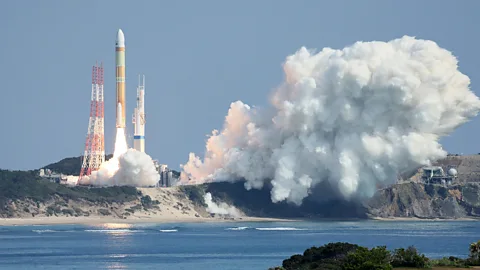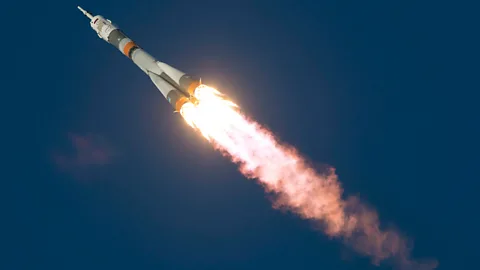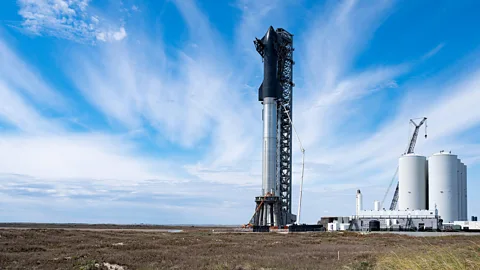What are the odds of a successful space launch?
 Getty Images
Getty ImagesThere's a lot that can go wrong on a rocket launch. Over the decades, however, the failure rate has been surprisingly consistent.
They make the biggest headlines, of course, when things go wrong.
Starship One was commercial space agency SpaceX's biggest launch to date. With a test model of its futuristic Starship spacecraft mounted on top of the enormous Super Heavy rocket, the debut launch of the Starship super-heavy lift vehicle was the subject of global anticipation. When the rocket lifted off in a massive cloud of smoke and dust from the launch pad at Boca Chica in Texas on 20 April 2023, it ushered in a new era of space exploration.
But not for long.
The debut launch of Starship would have seen the rocket do a solitary lap of Earth before entering a controlled re-entry of the Earth's atmosphere and splashing down in the warm waters of the Gulf of Mexico. But three of the Super Heavy booster's 33 engines did not fire on launch, and more failed as it lifted further into the air. Nearly four minutes after initial lift-off, the rocket started tumbling wildly and was deliberately exploded over the Gulf.
The first-flight failure of Starship One was a very high-profile casualty in the 21st Century's new race for space. SpaceX said its failure provided many key lessons for the next launch, which will only take place after weeks of clean-up at the badly damaged Boca Chica site. SpaceX don't consider it a failure, but a springboard to solving issues before the next launch.
But failures – loud, explosive failures – often make for better footage and news stories than routine successes, and often get wider coverage. More than 75 years since humanity started sending rockets into space in earnest, how likely is a successful rocket launch?
David Wade is one of those who weighs up just what the risk may be. Wade is an underwriter at Atrium Space Insurance, an insurance agency which supports commercial space launches. "Last year (2022), there were 186 launches," he says. These carried 2,509 satellites into orbit, the majority of those being Starlink, SpaceX's satellite internet constellation. "Satellites are launched up to 60 at a time on the [SpaceX] Falcon 9," says Wade. But out of 186 launches, there were only eight failures."
You might also like:
That works out to around a 4% failure rate – one in every 25 launches. But Wade says 2022 was an anomaly. Last year broke records in terms of the number of rocket launches – to give some idea of just how quickly space traffic is growing, there were 40 more in 2022 than in 2021 and double the number five years earlier in 2017. But with that extra traffic has also come increased risk.
"I would say, last year, we saw more failures than in some years, because we're starting to go through a phase where we're seeing quite a few new launch vehicles being introduced," says Wade. And early flights of launch vehicles are always more problematic."
The likes of Starship One and Nasa's Artemis programme – which launched successfully for the first time in November 2022 – are the most charismatic of these new launch vehicles. But they are only the tip of the iceberg. With new launch vehicles comes more uncertainties, especially with those first few flights.
SpaceX's Starship cleared the launchpad but exploded a few minutes into its maiden flight
"Typically, first or second launch, you expect something like 30% of them to fail," says Wade. "Then things start to get better thereafter, by the time you're up to the 10th flight, you're probably looking at a less than 5% failure rate.
"It's very difficult to really pinpoint exactly why some fail, some don't," he says. "You see a lot of effort go into the first two or three, they are huge amounts of research, a huge amount of quality control, making sure everything's fine. And yet, we still see failures, because something unexpected happens, usually within the first couple of flights."
Among the recent high profile failures in 2023 was Virgin Orbit's attempt to launch its first ever satellite mission from UK soil. The company closed down in May after the launch attempt earlier in the year, where the rocket failed to reach the required orbit to release its payload of satellites.
But once humans are involved in a launch, the extra precautions and checks needed to ensure a crews safety do seem to pay off.
"The launch failure rate (all time) for manned/human-carrying missions are lower at around 2%, and only around 1% involve a total failure to orbit," says David Todd of Seradata, a space industry analyst which has been tracking orbital rocket launches since Sputnik in 1957. "This lower failure rate is because the venerable Russian Soyuz rocket, which has flown many of the manned flights, has been used for several decades and is very reliable. Also, as you would expect, extra care is taken over human spaceflight.
"We count the fatal re-entry loss of the STS-107 Columbia Space Shuttle in 2003 as a 'launch failure' as the damage to the thermal protection system occurred during launch. Note also that human spacecraft carry launch escape systems which can save a crew in the event of a launch failure – Soyuz 18A in 1975 is an example."
Throughout 2022, SpaceX launched the successful Falcon 9 rockets at the rate of one every six days. China also broke its own record, launching 64 rockets of which only two ended up failing. Even New Zealand – hardly a household name when it comes to space launches – managed to launch nine rockets from a fledgling spaceport on the east coast of the North Island.
This new flurry of activity offers interesting challenges for the relatively new field of space insurance; Wade uses the forthcoming European Space Agency rocket Ariane 6 as an example. "If we were approached on an Ariane 6 right now, to insure a satellite going on… say on the third flight of Ariane 6, we would probably say, 'Well, our quote is subject to the first two been successful, right?' We have conditions in there – if one of them fails, we're off the hook."
Advanced computer modelling and the decades of experience in getting rockets into orbit mean designers have a much better idea of what to expect, says Wade. But every new launch system comes with unknowns, and how it behaves is hypothetical until that first launch.
 Getty Images
Getty Images"You've got hot, high-pressure gases, very rapidly changing environments. If something starts to go wrong, you can't do an awful lot to stop it," says Wade.
There are those who have crunched the numbers of space launches over the last eight decades and can paint a picture of just how likely failure is. Every week, new launches are entered into Seradata's database, which goes out to customers including insurance companies such as Wade's.
Seradata's understanding of failure also includes the rocket's payload not reaching the intended orbit or it being significantly damaged in launch, not just failing to achieve orbit.) Look at launches in the 1950s, in those first stumbling leaps of the space race, and the failures rates are shockingly different – more than 70%. It only took until the early 1960s for this number to start falling and it has hovered around the same point ever since – around 7% (9% if satellite-related launch failures are included).
"You always have teething troubles at the start of a career, big failures," says Todd. "And then, as time goes on for Western launch vehicles, we always say it achieves nirvana."
The same can't always be said for rockets made in countries like Russia, however. The Proton launch system, which launched Soyuz modules for the ISS in between the retirement of the Space Shuttle and the launch of SpaceX's Dragon spacecraft, has somewhat bucked the trend. "The Proton launch vehicle, which has flown since 1965, had a shocking record," says Wade.
He compares the Proton's success rate to the European Ariane 4 and the American Delta II rocket, both of which chalked up more than 100 successful launches in a row. "What you used to see with Proton was… there'd be a failure every 20 to 25 flights. I think in Russia, in the 1960s, you saw a lot of people come into the industry because of the space race. These were the best and brightest people straight out of university, the absolute best graduates."
Wade says the end of the space race and the fall of the USSR drastically reduced the Russian space industry, leaving it short of cash resources. "A lot of that knowledge was lost. And I think, you know, for something like Proton where you had a guy building a component, who knew that although the instructions say this, you just did a one-quarter extra turn on the lathe and that works better."
 Getty Images
Getty ImagesWhen it comes to the debut launches of new rockets, Starship One's failure looks perfectly plausible – even eight decades after the start of the Rocket Age, a new rocket series' first launch has almost a one-in-two chance of failing, says Todd. And the evolving space industry has called for new rocket after new rocket.
"One of the issues is progress," says Todd. "Rockets start off, develop badly, but eventually they get really good. Then the rocket designers are asked to build a better rocket and so they start again."
Wade, meanwhile, has discovered another interesting pattern hidden amid the data: the likelihood of a failure suddenly goes up on the sixth launch. "We see typically, two in the first 10 flights fail, and the first and second typically have a failure rate of something like 30%. And then it follows a nice curve down.
"The sixth flight has a particularly high prevalence of failure. And it's difficult to know exactly why – it could be by that stage, you start getting into the routine manufacture. Quality control isn't quite there yet. The extra quarter turn of the lathe or whatever it is, that hasn't quite been worked out."
--
